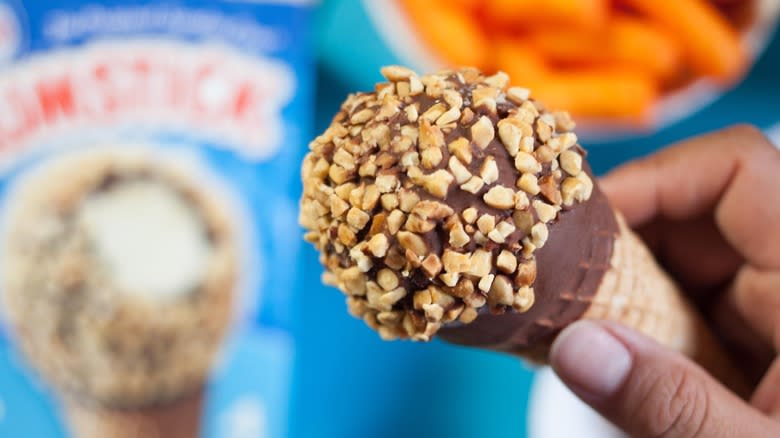The Reason Nestlé's Drumsticks Don't Melt

Remember the ice cream guy from Disney's "Lilo and Stitch?" He's the sunburned beach guy, always spotted with his iconic ice cream cone. Yet, we never actually see him eat it, as every time he tries, the Hawaii heat thwarts him and his sweet treat melts to the floor. We all feel his struggle -- being outside in the summer heat, racing against the blistering sun to finish our ice cream cone. But there's one frozen dessert that won't do you dirty like this: Nestlé's Drumsticks.
In February, the official Drumstick TikTok posted a video of a woman "studying" until her Drumstick melted, which of course, didn't happen. The internet lost its collective mind, with countless other videos showing similar results and many people, horrified, banning Drumsticks from their lives. But science tells us there's not much to worry about.
The reason the desserts don't melt is because they are made with emulsifiers. These natural or man-made ingredients, which are approved by the U.S. Food and Drug Administration (FDA), are added to foods, particularly those that are heavily processed, to stabilize them. Think oil and water: These two don't mix, but when emulsified, they do. The same thing is happening in Drumsticks: The ingredients don't mix in a way that satisfies the shelf life or stability of the item, so they add an emulsifier to create the creamy texture we all know and love while also preventing the treats from melting. The emulsifiers used in Drumsticks include soy lecithin, guar gum, monoglycerides, and carob bean gum.
Read more: 23 Best Ice Cream Brands Ranked
Are Nestlé's Drumsticks Safe?

To quell all the fears in the room with us, yes, your favorite cold treat is safe to eat. Emulsifiers are an important facet of modern food (and cosmetics) production and are generally considered safe to consume in moderation. But, as with the fear-mongering of the Nestlé Drumstick, if you look up "emulsifiers" on TikTok, you are likely to find tons of videos stating the ingredients are irreversibly harmful to gut and general health. Most of these claims, however, are not backed up; while there has been some research into the negative health effects of emulsifiers, none of it has come back completely conclusive.
It's also important to note that Drumsticks simply ... aren't real ice cream. They say so right on the front of the package: They are a "frozen dairy dessert cone." This is a very intentional labeling, as the product does not qualify as "ice cream" under the FDA's guidelines. According to the FDA, to be considered ice cream, it must be composed of dairy products and contain at least 10% milkfat.
It is up to you as a consumer to decide what you feel safe consuming, whether that's based on FDA regulations or other research. No matter what you decide, though, you will be just fine eating the occasional Drumstick on a hot summer day.
Read the original article on Tasting Table.


